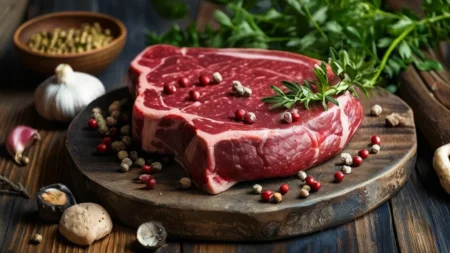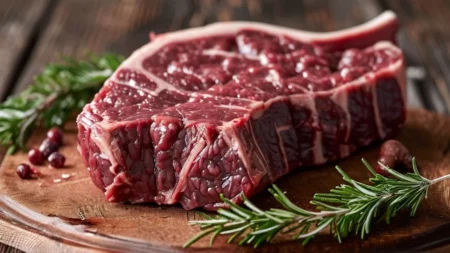Ground Pork: A Flavorful, Versatile Protein
Key Takeaways:
- Ground pork offers a rich, savory flavor and is often used in a variety of dishes worldwide.
- It is higher in fat than leaner meats, but it also provides essential vitamins like thiamine and minerals like zinc.
- Ground pork is ideal for flavorful dishes such as sausages, meatballs, and stir-fries.

Nutritional Profile of Ground Pork
Ground pork is known for its rich flavor and moderate fat content. Here’s a breakdown of its nutritional value per 100 grams (3.5 oz) of cooked ground pork:
| Nutrient | Amount |
|---|---|
| Calories | 242 kcal |
| Protein | 18 grams |
| Total Fat | 18 grams |
| Saturated Fat | 6.8 grams |
| Thiamine (Vitamin B1) | 0.8 mg (66% DV) |
| Zinc | 3.5 mg (30% DV) |
| Selenium | 35 mcg (65% DV) |
Rich in Protein and Healthy Fats
Ground pork is a high-protein food, and although it contains more fat than leaner meats like chicken, it is a rich source of flavor and essential fatty acids.
Health Benefits of Ground Pork
Ground pork provides more than just flavor—it’s also packed with nutrients that contribute to various health benefits.
1. Supports Immune Function
Ground pork is an excellent source of zinc, a mineral vital for maintaining a healthy immune system. Zinc plays a key role in wound healing and immune response.
2. Boosts Energy Levels
Pork is rich in thiamine (vitamin B1), which is crucial for energy production and the proper functioning of the nervous system. It helps convert carbohydrates into energy, making it essential for active lifestyles.
3. Promotes Healthy Metabolism
The B vitamins found in ground pork, especially B6 and B12, help maintain a healthy metabolism and are important for brain function and red blood cell formation.
Types of Ground Pork
Ground pork can come from different parts of the pig, influencing its fat content and use in cooking. Here’s a comparison of different types of ground pork:
| Type | Fat Content | Best Uses |
|---|---|---|
| Lean Ground Pork | 10-15% fat | Ideal for stir-fries, pasta sauces, and light dishes |
| Regular Ground Pork | 20-30% fat | Great for sausages, burgers, and meatloaf |
| Ground Pork Shoulder | 25-35% fat | Best for slow-cooked dishes and flavorful patties |
Popular Dishes Made with Ground Pork
Ground pork’s versatility makes it a favorite ingredient across different cuisines. Here are some popular dishes where ground pork truly shines:
1. Pork Dumplings
In Asian cuisine, ground pork is often the filling of choice for dumplings. Combined with garlic, ginger, and scallions, it delivers a burst of savory flavor wrapped in delicate dough.
2. Pork Meatballs
Pork meatballs are tender and full of flavor, whether served with pasta, as part of a soup, or on their own as an appetizer.
3. Pork Sausage
Ground pork is the base for many homemade sausages. You can add herbs, garlic, and spices like fennel and paprika to make your own fresh sausage blend.
Cooking Tips for Ground Pork
Ground pork can be used in a wide variety of dishes, but it requires some specific cooking techniques to get the most out of its flavor.
1. Avoid Overcooking
Ground pork should be cooked to an internal temperature of 160°F (71°C) to ensure it’s safe to eat without losing its moisture. Overcooking can cause the pork to become dry and tough.
2. Balance the Fat
Because ground pork is higher in fat, it’s important to pair it with ingredients that absorb or complement the richness. Vegetables, rice, or noodles work well to balance the dish.
3. Season Generously
Ground pork has a bold, rich flavor, but it can be enhanced with seasonings like garlic, soy sauce, ginger, or rosemary depending on the dish you’re preparing.
Ground Pork vs. Ground Beef: A Nutritional Comparison
Both ground pork and ground beef are popular proteins, but they differ in nutritional content. Here’s a comparison between the two:
| Nutrient | Ground Pork (85% lean) | Ground Beef (85% lean) |
|---|---|---|
| Calories | 242 kcal | 250 kcal |
| Protein | 18 grams | 22 grams |
| Total Fat | 18 grams | 17 grams |
| Saturated Fat | 6.8 grams | 6.7 grams |
| Iron | 1.1 mg (6% DV) | 2.6 mg (15% DV) |
While ground pork has a similar calorie and fat profile to ground beef, it contains less protein and iron. However, pork is richer in certain vitamins, like thiamine, making it a good choice depending on dietary needs.
Conclusion
Ground pork is a flavorful, nutrient-dense option for those who enjoy rich, savory dishes. It offers essential nutrients like zinc, selenium, and B vitamins, supporting immune health and energy metabolism. Its versatility in a range of global cuisines, from dumplings to meatballs, makes it a valuable addition to any kitchen. Whether you prefer lean or fattier cuts, ground pork can be adapted to suit many dishes, delivering both flavor and nutrition.
FAQ
Q: Can ground pork be used as a substitute for ground beef?
A: Yes, ground pork can be used in place of ground beef in many recipes. It has a similar texture but offers a richer flavor. Keep in mind that ground pork is typically fattier than ground beef, so you may need to adjust cooking times and seasoning.
Q: How long can I store ground pork in the refrigerator?
A: Fresh ground pork should be used within 1-2 days when stored in the refrigerator. Cooked ground pork can last up to 4 days in an airtight container.
Q: Is ground pork healthier than ground beef?
A: Both ground pork and ground beef have nutritional benefits. Pork is higher in certain vitamins, like thiamine, while beef is a better source of iron. The choice depends on your dietary needs and the dish you’re preparing.
Q: Can I freeze ground pork?
A: Yes, ground pork freezes well. It can be stored in the freezer for up to 3 months. Thaw it in the refrigerator overnight before using for best results.
Q: How do I know when ground pork is fully cooked?
A: Ground pork should be cooked to an internal temperature of 160°F (71°C) to ensure it’s safe to eat. Use a meat thermometer to check the temperature while cooking.










